At a time when Tesla dominates the battery-electric vehicle sales charts, there are a number of EV startups that see the opportunity to crack into the long-closed U.S. automotive market. While most should be considered long shots, Rivian is a clear standout thanks to two impressive new retail products — as well as significant financial backing.
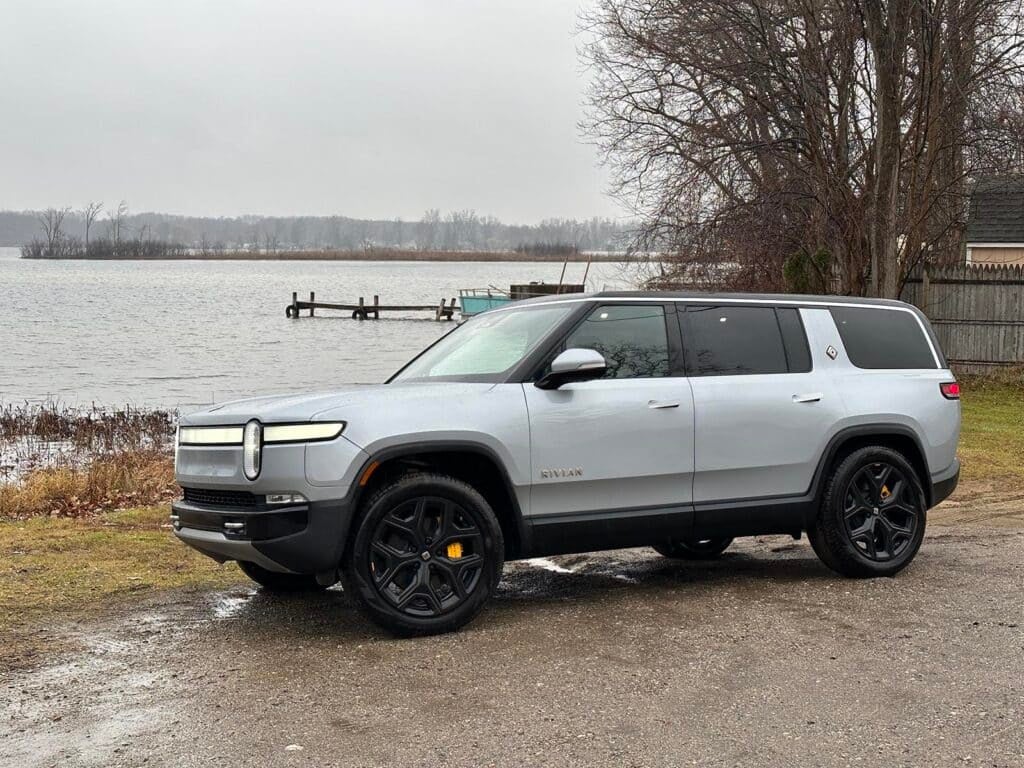
The automaker made its debut a year ago with the rollout of the R1T pickup and it’s now turning heads with the addition of the all-electric R1S. Like the pickup, the full-size sport-utility vehicle features a distinctive design and boasts substantial space for passengers and cargo. It’s got solid range and a battery that can be charged reasonably quickly. It also offers great performance and a broad array of high-tech features.
TheDetroitBureau.com had a chance to spend a full week behind the wheel of the R1T over the extended Thanksgiving holiday and here’s what we learned.
Overview
Taking direct aim at the Tesla Model X, the new Rivian R1S is the second entry from the California-based EV startup.
The big SUV shares the same platform as Rivian’s first entry, the R1T pickup, though it’s about a foot shorter, overall, and replaces the cargo bed with a reasonably roomy third row and plenty of cargo space, both under the hood and behind that back bench.
While an even longer-range battery pack is in the works, the R1S already delivers solid numbers, an EPA-rated 316 miles per charge using a 128.9 kilowatt-hour pack. And its high-voltage design allows for reasonably quick recharging — as much as 140 miles in 20 minutes using a 150-kilowatt DC fast charger.
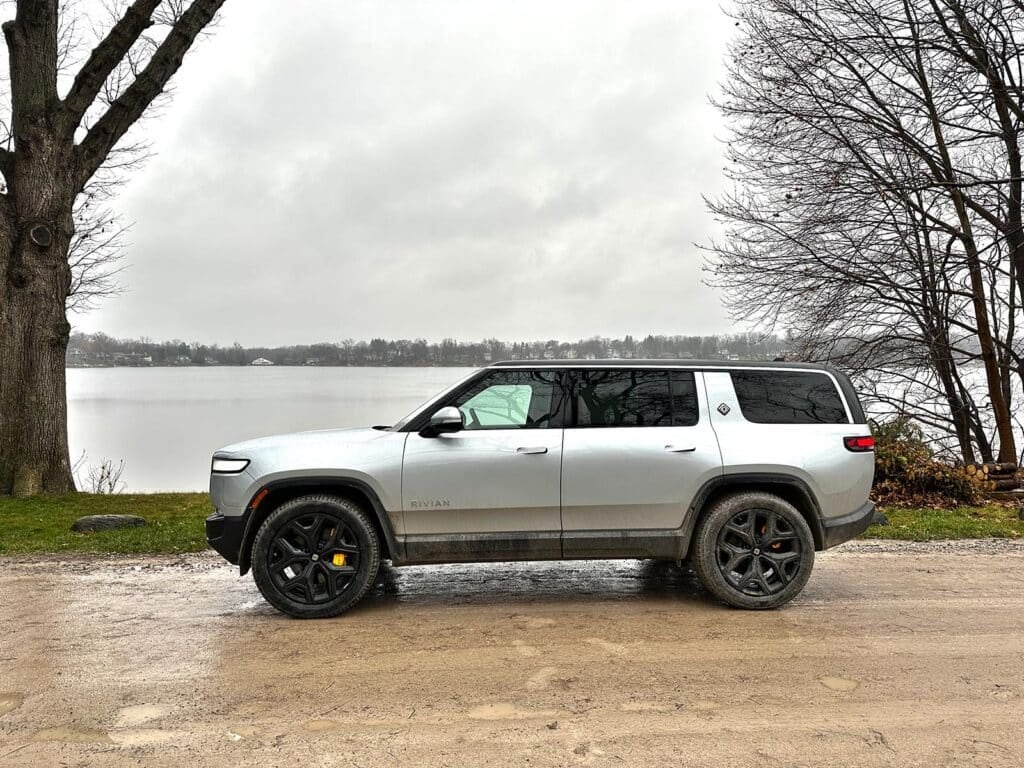
With four motors putting out as much as 835 horsepower, the R1S is plenty quick — and manages an impressive payload capacity of 1,800 pounds. It also can tow up to 7,700 pounds. Coming with a standard, adjustable-height air suspension, the Rivian SUV also can handle serious off-road conditions — especially when equipped with optional, knobby trail-rated tires.
Exterior
Spot the all-electric SUV in your rearview mirror and you might confuse it with the original Rivian R1T pickup. They share not only the same, underlying skateboard-style platform, but an essentially identical front-end design.
That starts with the broad light bar that stretches across the SUV’s nose, just below the hood, wrapping into the front quarter panels. The R1S also features vertical oval headlights, perhaps its most distinctive feature. And, the reality is that the “grille” really isn’t. Like other EVs, there’s no powertrain under the hood to feed air into, though intakes under the bumper do provide the air necessary to cool the truck’s motors and battery pack.
The R1S is about a foot shorter than the R1T pickup, trading its cargo bed for the space needed to add a third row of seats and a reasonably large cargo compartment.
Overall, the Rivian is far more conservative in styling than the similarly sized Tesla Model X and, from a profile view, you might initially confuse it with a more conventional SUV. One clue that it’s electric, however, comes with the aerodynamically styled pop-out door handles.
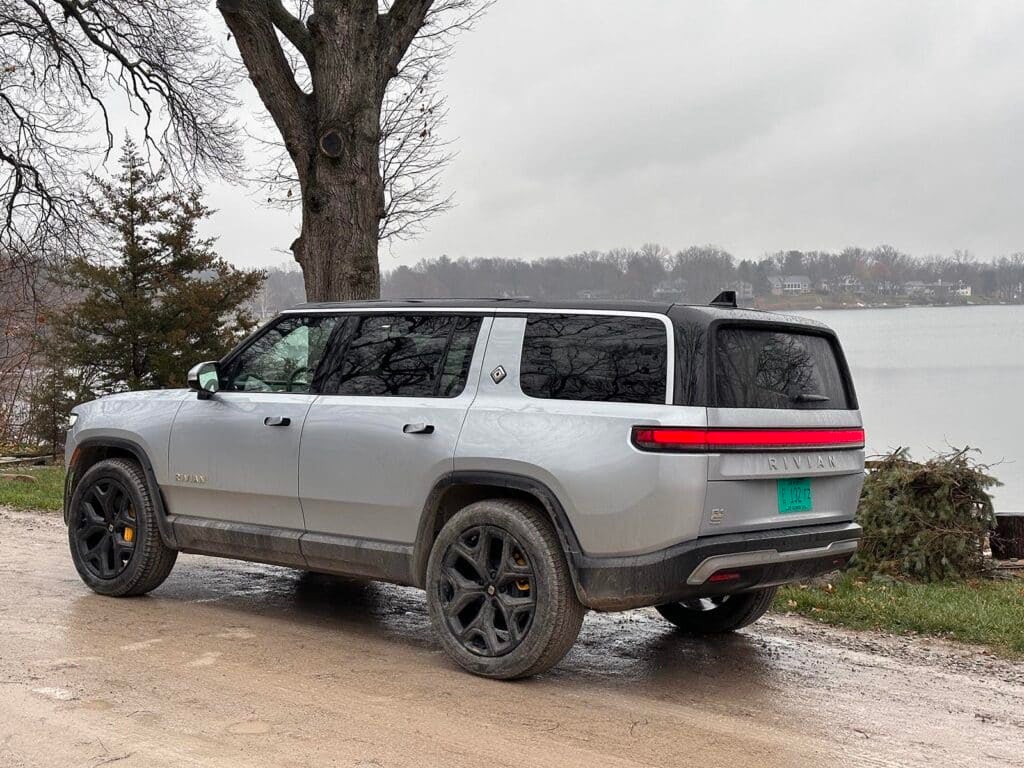
Interior
As with the R1T pickup, the all-electric SUV features a sleek and sophisticated interior design. It’s almost Scandinavian-style in look and feel. It helps to be able to recapture some of the space normally required for an engine compartment and repurpose it for a larger passenger and cargo compartment — with three rows and seven seats. Meanwhile, tap a button on the keyfob and the power-lift hood opens up to reveal a 12 cubic foot “frunk,” or front trunk.
The Rivian R1S Launch Edition features elegantly detailed wood accents on the instrument panel, though your eyes are likely to be drawn, at least initially, to the truck’s large twin video displays. There’s a brightly lit screen behind the steering wheel replacing conventional analog displays, and it reconfigures itself, as needed, depending upon the mode the truck is operating in. A wide touchscreen stretches across the central IP and operates virtually all vehicle functions, from climate control to navigation, mode settings, suspension height and even the positioning of outside mirrors and the steering wheel.
There’s a dearth of conventional controls, however, with only stalks to handle critical functions — such as windshield wipers, turn signals and cruise control. There are also two pair of multi-function controls on the steering wheel itself. More on how this all works in a moment,
The seats are nicely detailed and use a vegan material, rather than conventional leather, though you’d be hard-pressed to tell the difference. Rivian also uses recycled materials for the headliner and floor mats that can be easily washed out after a day at work or on the trail. A massive glass roof completes the look. Rivian claims that it filters out most UV light and limits the cabin’s heat load on hot days — something I didn’t have a chance to confirm.
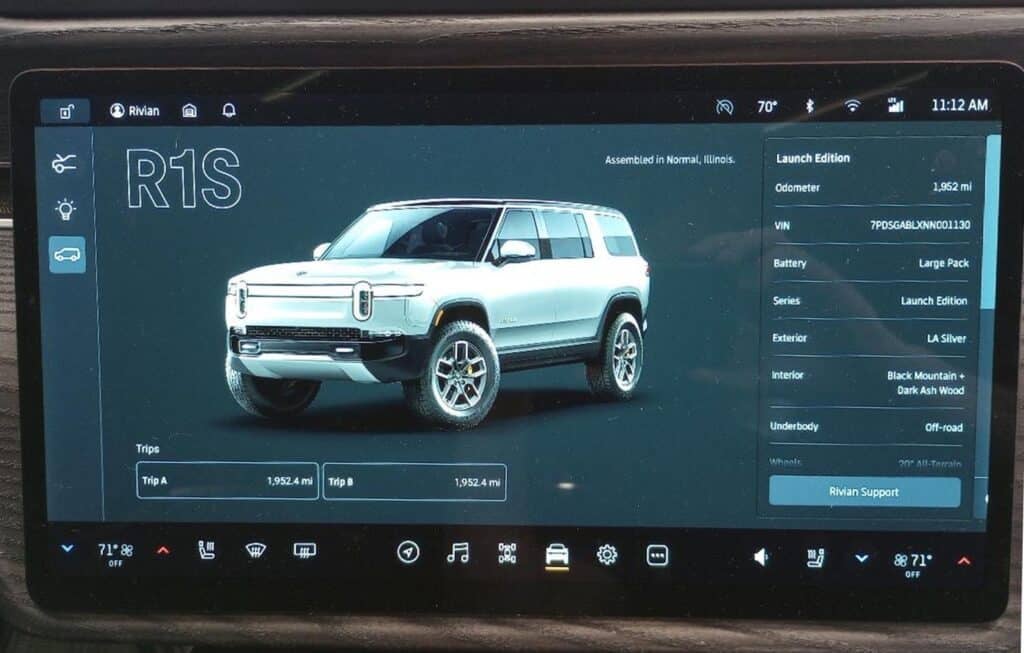
The R1S I drove featured center-row buckets and a third-row bench. It provided plenty of space for each occupant, with one of the most comfy nooks in back for what, in most vehicles, is a penalty box for adults who get stuck there.
Powertrain
The underlying platform used for both the Rivian R1S and R1T models, allows for plenty of powertrain flexibility. In the case of my “LA Silver” Launch Edition, the SUV featured twin drive units, each consisting of two individual motors, or one motor per wheel. That layout has numerous advantages when it comes to distributing torque where it is needed at any given moment.
Rather than having to apply individual brakes or use complicated differential systems, everything is done through software. That means a responsive all-wheel-drive system, as well as torque vectoring. The latter reduces power to the inside wheels to help improve handling while cornering.
While I didn’t have the opportunity to put the Rivian onto anything rougher than some dirt and gravel roads, the R1S can be shifted into off-road mode, the air suspension raising itself up to provide as much as 15-inches of ground clearance. In off-road mode, settings for throttle and braking, among other functions, also are revised.
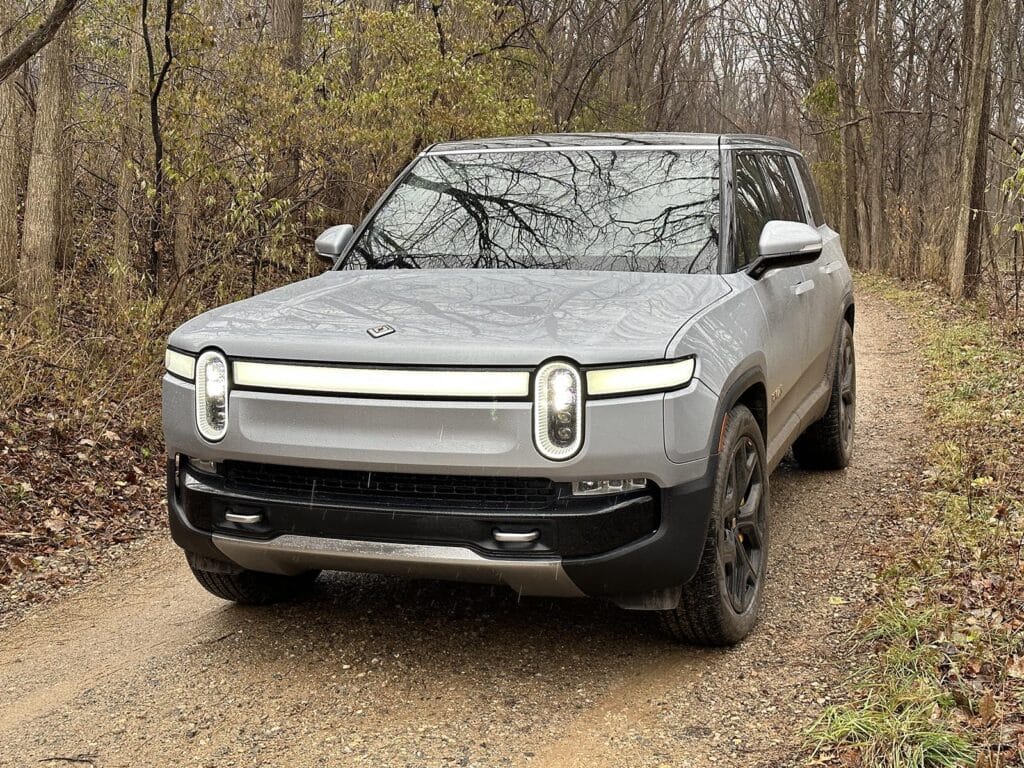
The Launch Edition produces 835 horsepower and about 900 pound-feet of torque. In Sport Mode, the suspension hunkers down as low as 5 inches off the ground, throttle response quickens and, should you mash the throttle, the R1S will hit 60 in just over 3.0 seconds. It doesn’t slow down at that point, readily reaching triple-digit speed. Meanwhile the R1S has enough muscle to tow up to 7,700 pounds.
The Long Range battery pack, with a useful capacity of 128.9 kWh, provides an EPA-estimated 316 miles per charge — two more than for the heavier R1T pickup. Note that range is a variable number with EVs and is susceptible to not only how hard you drive it but also weather conditions. Using the battery to heat the SUV’s cabin clearly impacted the numbers during my week behind the wheel. I was getting something around 260 miles on a fully charged battery. The R1S has an EPA rating of 73 MPGe which means it isn’t nearly as efficient as the Tesla Model X.
The automaker claims you can get up to 140 miles of additional range when plugged into a high-speed public charger in 20 minutes. A built-in 11.5 kilowatt 240-volt charger can top the pack up overnight, Rivian also said, the system yielding an additional 16 miles of range per hour.
Note that Rivian plans to add both a standard battery pack, expected to yield around 260 miles, as well as a 400-mile “Max” pack, in 2023.
Safety and Technology
The Rivian R1S is one of the most high-tech vehicles on the road and that translates into a range of high-function digitally controlled features that yield reasonably good range, great performance and the capability to drive pretty much anywhere, on-road or off. Certainly, on paper, that’s impressive. But there is a downside.
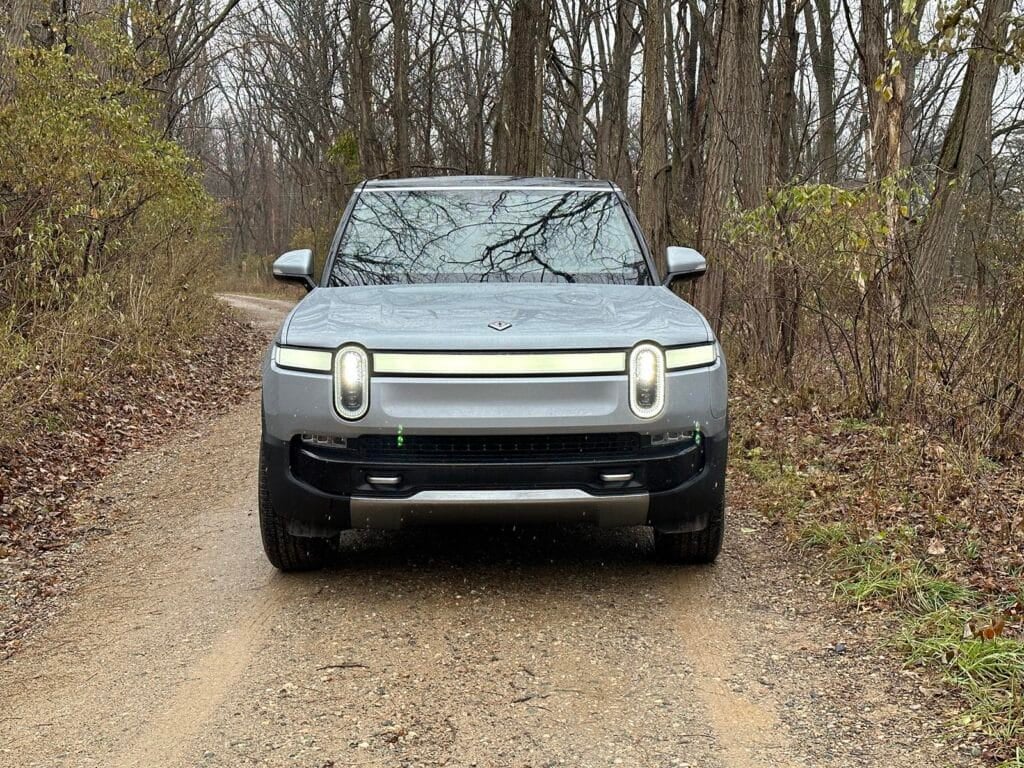
If you’ve ever tried to grasp how to use all the features on Microsoft Word or Adobe Photoshop, well, you’ll get an idea of what it’s like learning how to operate the Rivian R1S. I consider myself quite tech savvy and I ended a week in the R1S, (and earlier time in the R1T), feeling like I barely had a comfortable grasp of how to operate things.
Rivian isn’t the only one to go this route, but it can be challenging, at least at first, to do simple tasks like turning on seat and steering wheel heaters. Even functions like cruise control and windshield wipers aren’t as intuitive as they should be.
It doesn’t help that the two steering wheel-mounted multifunction controls aren’t backlit. It’s easy to screw up when it’s dark out. Same for the rubberized keyfob which doesn’t even attempt to make its four buttons easy for an owner to see.
At least the basic positioning controls for the seats are conventional and mounted where you’d expect to find them. But you’ll have to navigate the touchscreen to address other seating functions.
All that said, once you do get a grasp of the system you have tremendous control of the vehicle, everything from climate to navigation, suspension to powertrain. I’d just love to see a few more manual controls, a bit more intuitive designs onscreen and on those manual controls — starting with a better key fob.
As for safety and driver assistance systems, the Rivian R1S uses an array of exterior camera, radar and sonar sensors to minimize the risk of a collision. They also take its standard adaptive cruise control up another notch. Double tap the shift lever and it activated the Level 2 Rivian Driver+ system. You still need to maintain a light touch on the steering wheel but the system effectively steers the big truck, while also maintaining a safe distance from surrounding traffic. The system is effective but is not up to the true hands-free capabilities of General Motors’ new Super Cruise. Nor can it automatically change lanes simply by tapping the turn signal, like Super Cruise.
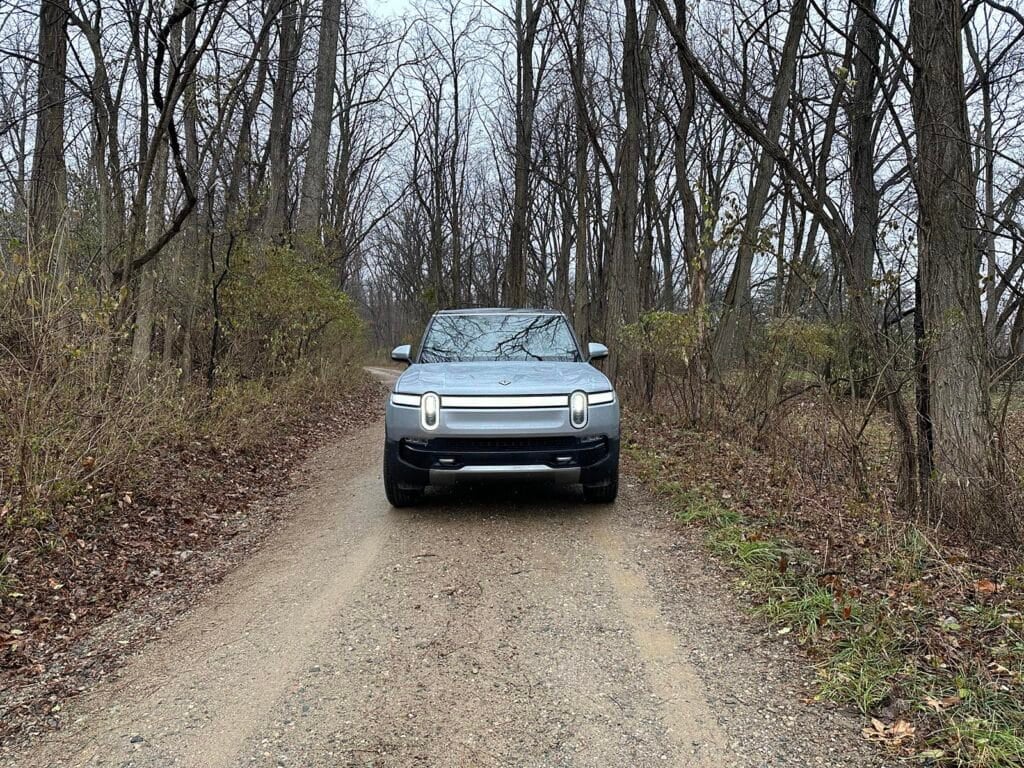
Another surprise: the lack of both Apple CarPlay and Android Auto, as well as Sirius/XM radio — though the all-electric SUV does include a WiFi hotspot, Qi wireless charging and the ability to use Amazon’s Alexa voice assistant.
Driving Impressions
Beyond my rant about Rivian’s complex digital control system, I was quite impressed by the overall performance and drive dynamics of the R1S.
Acceleration is one small notch short of spectacular. Despite a curb weight of 6,986 pounds, the SUV launches like a sports car, hitting 60 in just over 3 seconds. Steering is solid, if a little heavy, and provides plenty of road feel.
The air suspension lets you adjust vehicle height manually – or automatically, by shifting drive modes – and that can make a big difference in the vehicle’s overall dynamics, depending upon whether you’re doing 80 on a freeway or creeping along on a rough off-road trail. I didn’t have the chance to challenge the R1S on anything rougher than gravel and rutted dirt, but it quickly became clear that it could handle most anything I might throw at it. (And I did have the chance to experience tougher conditions with the R1T pickup earlier in the year.
While the R1S Launch Edition is essentially fully equipped you do have a few choices to make beyond color. I spent my first day driving an R1S with knobby, oversized off-road tires. They significantly degraded the on-road drive experience; they were rough and the SUV had a tendency to tram, or subtly weave in its lane. The on-road tire packages, Pirelli Scorpion Zero All Season Elect, was a major improvement, soaking up more of the harsh bumps Michigan roads are known for, though the ride was still harsher than in the Tesla Model X and even the Ford F-150 Lightning pickup.
2022 Rivian R1S Specifications
| Dimension | L: 200.8 inches/W: 81.8 inches/H: 73 inches/Wheelbase: 121.1 inches |
| Weight | 6,986 pounds |
| Powertrain | four permanent magnet synchronous AC motors (two front and back) |
| Fuel Economy | 316 miles of range; 73 MPGe city/65 MPGe hwy/69 MPGe combined |
| Performance Specs | 835 horsepower and 900 pound-feet of torque |
| Price | Base price: $72,500; As tested: $90,000 plus n/a destination charge. |
| On-Sale Date | Available now |
Wrap Up
There’s a lot to like, if not outright fall in love with, on the Rivian R1S. It’s distinctively styled, offers tremendous passenger space and room for cargo. It has phenomenal performance and plenty of power to haul and tow heavy loads.
Techies will clearly love the extensive capabilities to control vehicle functions, as well as the SUV’s huge screens. But there are some surprising shortfalls, starting with the lack of Apple CarPlay, Android Auto and Sirius/XM radio. And for those who aren’t particularly tech-savvy, maneuvering through the complex user interface might prove overwhelming.
Those shortfalls should be a caveat for some buyers. But plenty of others are likely to fall in love with all the things the Rivian R1S offers and accomplishes. It’s an impressive sophomore entry, after the original R1T pickup. And, with rare exception, its weak points should be relatively easy to address since most are software-related. Indeed, with the ability to revise code using smartphone-style over-the-air updates, I’m expecting to see upgrades coming along in the near future.
And those could make a solid all-electric offering even more compelling.
For potential buyers, one other factor to work in is pricing — which starts at $72,500 for the base R1S Explore model, and jumps to $90,000 for the Launch Edition. Those are big numbers — but they’re also a good deal if your alternative pick were the Tesla Model S. And, for my money, I’d probably go with the Rivian.
2022 Rivian R1S — Frequently Asked Questions
Is the Rivian R1S a good buy?
The Rivian R1S offers a broad array of useful features, plenty of room for passengers and cargo and a dynamic driving experience. But you’ll pay a steep price for this EV startup’s first SUV. The entry model, the R1S Explore, starts at $72,500, with the top-line Launch Edition going for $90,000.
What is the wait time for a Rivian R1S?
Plagued by parts shortages, there’s a shortage of almost all vehicles right now. That’s especially so for high-tech vehicles like the Rivian R1S that are particularly dependent upon the semiconductor chips currently in seriously short supply. Wait times of two months or more are commonplace — and it can run significantly longer.
How big is the Rivian R1S?
The three-row Rivian R1S is a full-size SUV that can seat seven while still offering plenty of room for cargo, both behind the third row and in the frunk, or front truck. It is, however, about a foot shorter in overall length compared to the Rivian R1T pickup.
- SEO Powered Content & PR Distribution. Get Amplified Today.
- Platoblockchain. Web3 Metaverse Intelligence. Knowledge Amplified. Access Here.
- Source: https://www.thedetroitbureau.com/reviews/a-week-with-2022-rivian-r1s/



